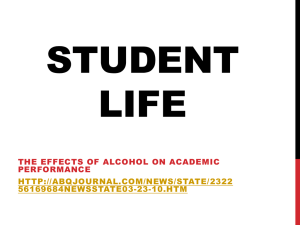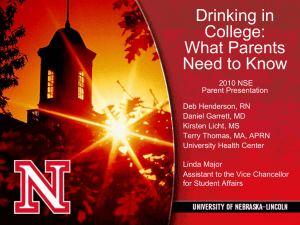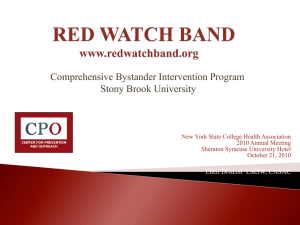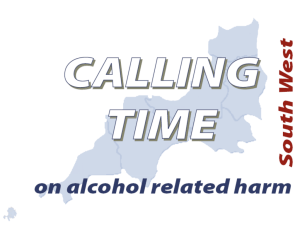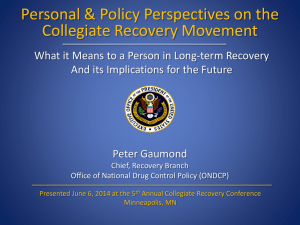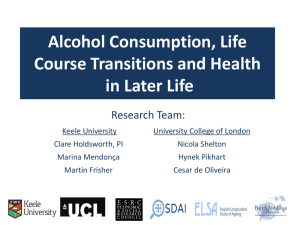Presentation - The National Documentation Centre on Drug Use
advertisement
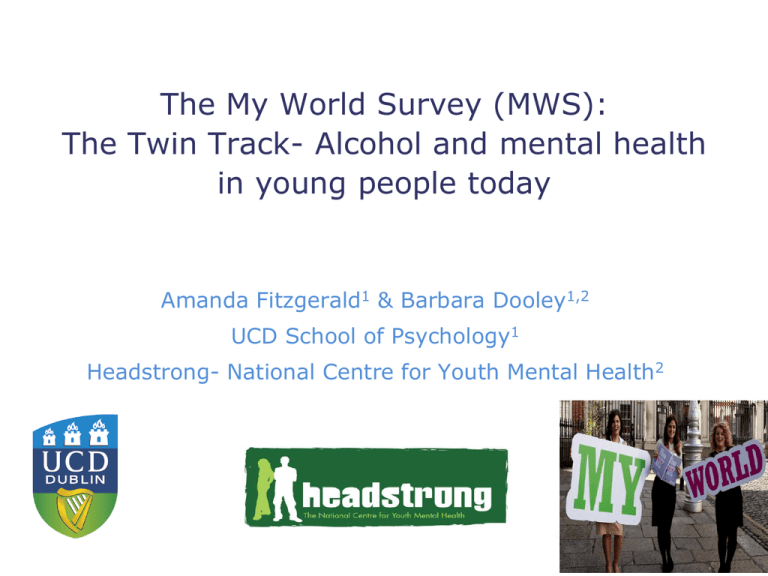
The My World Survey (MWS): The Twin Track- Alcohol and mental health in young people today Amanda Fitzgerald1 & Barbara Dooley1,2 UCD School of Psychology1 Headstrong- National Centre for Youth Mental Health2 The context • Drinking is part of the Irish culture • Research in Europe and the US has found that alcohol use is beginning in early adolescence, consumption rates are increasing and polysubstance use is evident (Newes-Adeyi et al 2005; WHO 2007) • Alcohol is a particular risk in adolescence(Strandheim et al 2009) • Underage and binge drinking have negative effects on adolescent development and mental health (Chen et al., 2008) When do mental health issues begin to emerge? Victorian Burden of Disease Study (1996) Aims • Describe patterns of drinking behaviour across the second level school cycle • Determine the associations between drinking behaviour, as defined by the WHO AUDIT tool, and mental health indicators • Investigate the link between alcohol misuse and suicidal behaviours among young adults Methodology • Sampling young people from 12-25 years of age in line with the WHO definition of adolescent and emerging adulthood – Second level students 12-18 (N = 6,085) • Randomly selected schools 72/145 participated (49%) – Third level students 17-25 N=8,221 • All universities and 5 ITs – Employed young people 18-25 (N =170) – Unemployed young people 18-25 (N =154) – Trainees 18-25 (N = 306) – Total sample: 14,936 The MWS • Positive Domains – Multidimensional Scale of Perceived Social Support (MSPSS) – Coping Strategy Indicator – Optimism – Resilience Scale for Adolescents (READ) – Self Esteem Scale (RSE) – Satisfaction with Life Scale • Negative Domains – – – – Alcohol Use Disorders Identification Test (AUDIT) Depression Anxiety Stress Scale (DASS) Behavioural Adjustment Scale (BAS) CRAFFT (risk taking scale) Data from Second Level Sample Data on alcohol frequency and binge drinking 49% (N=2784) of adolescents never drink alcohol School year % of drinking at least monthly % of drinking, at least monthly, 6 or more drinks in one session 1st year 6% 15% 2nd yr 13% 21% 3rd yr 22% 28% 4th yr 33% (11% weekly) 33% 5th yr 52% (19% weekly) 47% (10% weekly) 6th yr 69% (28% weekly) 57% (16% weekly) Typical drinking volume • In 3rd yr the most prevalent typical drinking volume is 1-2 drinks (30%), 3-4 drinks (24%), 5-6 drinks (25%) • In 4th yr the most prevalent typical drinking volume is 3-4 drinks (38%), 5-6 drinks (24%) • In 5th & 6th yr the most prevalent typical drinking volume is 5-6 drinks (30%), 7-9 drinks (22%), with 15% of 6th yrs drinking 10+ on a typical drinking occasion Alcohol behaviour classification –AUDIT (WHO, 2001) Classification Junior Cycle (1st, 2nd, 3rd year) Senior Cycle (4th, 5th, 6th year) Low risk drinking 90% 65% Problem drinking 6% 26% Hazardous drinking 2% 5% Possible alcohol 2% dependence 4% AUDIT recommended cutoffs for adolescents (Knight et al., 2003; Santis et al., 2009) Classification Junior Cycle (1st, 2nd, 3rd year) Senior Cycle (4th, 5th, 6th year) Low risk drinking 78% 33% Problem drinking 22% 67% Alcohol behaviour across school year • Significant linear trend F(5,5807) =242.37, p < .001. 6th yrs M=8.55, are in the problem drinking range and are significantly different from all other years • Similar pattern for males and females Alcohol behaviour across age group • Significant linear trend F(6,14311) =691.67, p < .001. Similar pattern for males and females Factors associated with use alcohol use in adolescents • Chi-square analysis observed : – Adolescents in the Junior Cycle, classified in problem drinking category, were more likely to report severe/very severe depression. This was also evident for those in the Senior Cycle, but the association was stronger for Junior Cycle. – These patterns also emerged for stress and anxiety – Alcohol behaviour was also linked to self-esteem, where problem drinking behaviour was associated with lower self-esteem. This was evident in both the Junior Cycle, and Senior Cycle Factors associated with use alcohol use in adolescents • Alcohol use was linked to positive and negative factors – Low levels of alcohol use were associated with higher optimism, support from family, life satisfaction and resilience – Higher rates of alcohol use were associated with increased risk taking, high family conflict, feeling angry, school misconduct and antisocial behaviour Data from Young Adult Sample (17-25 years) Alcohol misuse and suicidal behaviour • WHO (2004) – Risk of suicide is 8 times greater when a person is currently abusing alcohol than if not abusing alcohol • Ireland ranked 4th in Europe for suicide rate in 15-24 yr olds (NOSP, 2010) • Young adults (17-25 yrs) who were identified as having a possible alcohol dependence were at increased risk for self-harm, suicidal thoughts and suicide attempts Conclusions • Problem alcohol behaviour has clear patterns of frequency, binge drinking and volume across year group in second level • Problem drinking was found to be linked to an increased risk for mental health difficulties and a reduction in self-esteem • Young people at low risk for drinking have better mental health, engage in more positive coping strategies and have a more positive outlook on life • Need to delay the onset of drinking Thank You! Email: amanda.fitzgerald@ucd.ie Link to My World Survey Report www.headstrong.ie/content/my world
